Penguin in a Tux Penguin Baby With Parents
| Quick facts for kids PenguinsTemporal range: Palaeocene–Recent | |
|---|---|
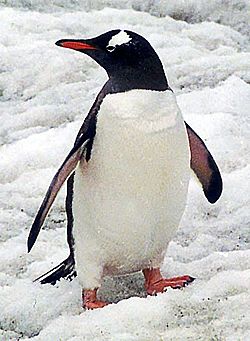 | |
| Gentoo penguin, Pygoscelis papua | |
| Scientific classification | |
| Kingdom: | Animalia |
| Phylum: | Chordata |
| Class: | Aves |
| Guild: | Sphenisciformes |
| Family unit: | Spheniscidae Bonaparte, 1831 |
Penguins are seabirds in the family Spheniscidae . They utilise their wings to travel underwater, merely they cannot travel in the air. They eat fish and other seafood. Penguins lay their eggs and raise their babies on country.
Penguins alive only in the Southern Hemisphere of the earth: Antarctica, New Zealand, Australia, Due south Africa and South America. The furthest north they become is the Galapagos Islands, where the common cold Humboldt Electric current flows past.
Contents
- Physical clarification
- Life
- Diet
- Different kinds
- Listing of penguins
- Images for kids
Physical clarification
All penguins accept a white abdomen and a dark, by and large blackness, back. This is a type of camouflage to go along them prophylactic when they swim, because it makes them alloy in with their background. The white and black colors make an result chosen countershading. When a predator looking from below sees the white belly and wings of a pond penguin, they can not see the penguin well considering the light is coming from above. However, when seen from above, the penguin's black back blends in with the night water below, so they are hard to see.
The biggest penguins may stand nearly 4 feet tall (110 cm) and can counterbalance almost 100 pounds (40 kg). The smallest kinds are only about one human foot (32 cm) tall.
Penguins have a thick layer of blubber that helps them proceed warm, and their feathers are very tightly packed to make some other cover. They likewise have a layer of woolly down feathers, under the outer veined feathers that are coated with a blazon of oil that makes them waterproof.
Penguins have webbed feet used for paddling in the water. They cannot walk well, so they waddle. Penguins cannot fly, but they can swim very well. Their wings have become stiff and small swimming flippers. They have adept hearing and can see underwater.
Life
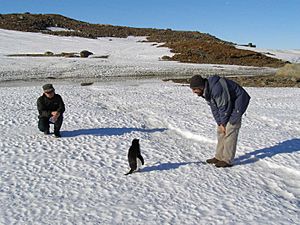
A penguin encounters a human during Antarctic summer.
Well-nigh penguins lay two eggs per year but emperor penguins lay only one. Afterwards the penguins mate, the mother lays her egg or eggs and soon goes in the body of water to consume. The father and mother take turns keeping the eggs warm, and the chicks warm after hatching. The parent on infant duty has nothing to eat. Parent penguins call to find each other amongst the thousands of birds when they return from the feeding grounds. The fourth dimension i parent is solitary with the eggs or chicks and going hungry may be weeks or months depending on what kind of penguin they are. If one parent does not return, the other must abandon the egg to go and eat.
Diet
Penguins consume krill, fish, squid, and other modest animals from the sea, which they take hold of. They are at home in the ocean. They come up on the land or ice to lay their eggs and raise the chicks. They don't eat there because they live in places where the land has no food for them. In near species the birds all nest together in a huge group, called a rookery. They usually brand nests on the ground with rocks or mud.
Penguins cannot gustatory modality fish. This was discovered when a research squad noticed they were missing some cardinal genes for gustatory modality. A closer look at the DNA of penguins showed that all species lack performance genes for the receptors of sweet, umami, and bitter tastes. Information technology doesn't matter to them, because they eat the fish whole.
Different kinds
There are 15-twenty living species (types) of penguins. The white-flippered penguin is today mostly considered a subspecies of the lilliputian penguin. It is notwithstanding unclear if the royal penguin is a subspecies of the macaroni penguin. Scientists are also uncertain whether rockhopper penguins are one, two, or three species.
List of penguins
Subfamily Spheniscinae – modernistic penguins
| Image | Genus | Living Species |
|---|---|---|
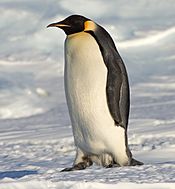 | Aptenodytes Miller,JF, 1778 – great penguins |
|
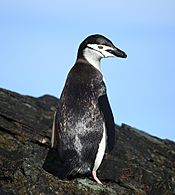 | Pygoscelis Wagler, 1832 – brush-tailed penguins |
|
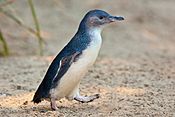 | Eudyptula Bonaparte, 1856 – little penguins |
|
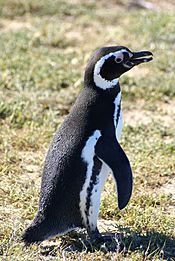 | Spheniscus Brisson 1760 – banded penguins |
|
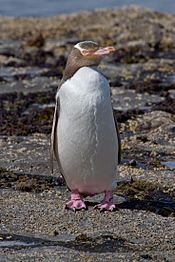 | Megadyptes Milne-Edwards, 1880 |
|
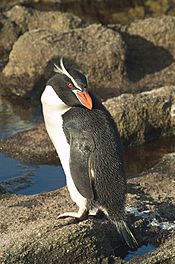 | Eudyptes Vieillot, 1816 – crested penguins |
|
Images for kids
-

Adélie penguin (Pygoscelis adeliae) feeding young. Like its relatives, a neatly bi-coloured species with a head marking.
-

Humboldt penguins in an aquarium. The penguin is an achieved swimmer, having flippers instead of wings.
-

Penguin wings have the aforementioned full general bone structure as flighted birds but the bones are shorter and stouter to let them to serve as fins. 1). Humerus 2). Sesamoid Os iii). Radius 4). Ulna v). Radial Carpal bone 6). Carpometacarpus 7). Phalanges
All content from Kiddle encyclopedia articles (including the article images and facts) can be freely used under Attribution-ShareAlike license, unless stated otherwise. Cite this article:
Penguin Facts for Kids. Kiddle Encyclopedia.
Penguin in a Tux Penguin Baby With Parents
Source: https://kids.kiddle.co/Penguin
Post a Comment for "Penguin in a Tux Penguin Baby With Parents"